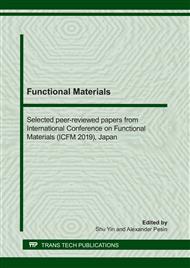p.51
p.59
p.65
p.73
p.81
p.87
p.95
p.103
p.109
Hydrometallurgical Process for Selective Extraction of Nd and Rare-Earth Metals from End-of-Life Hard Disk Drives NdFeB Magnet Scrap
Abstract:
This paper proposed a recycling process for neodymium-iron-boron (NdFeB) magnet scrap from the end-of-life (EOL) of hard disk drives by using hydrometallurgical process. Initial chemical composition of NdFeB magnet scrap was consisted of 25.37%Nd, 6.53%Pr, 0.90%Co, 3.63%B and 63.57%Fe. After de-magnetization and crushing into proper size, magnet scraps were directly leached by H2SO4 solution. More than 90% dissolved into acid solution with remaining small amount of residuals and Ni-coated metal. Neodymium precipitated from leached solution by pH-control to the optimum condition at pH 0.6 using NaOH solution. Solid Nd-precipitates XRD pattern was observed in form of NaNd (SO4)2.(H2O) and FeSO4.(H2O). Elemental analysis of Nd-precipitates by WD-XRF. The precipitates contained 26.50%Nd, 8.46%Pr and 1.19%Fe. In order to elimination of Fe, Nd-precipitates was leached by using H2SO4 solution to dissolve FeSO4.(H2O) into acid solution to obtain high concentration of Nd and rare-earth metals (REMs) compound. As a result, XRD pattern of Nd-compound after Fe-removal confirmed that the high purity NaNd (SO4)2.(H2O) compound was obtained. The final composition of precipitates analyzed by WD-XRF was 26.36%Nd, 8.13%Pr with Fe as low as 0.14%Fe.
Info:
Periodical:
Pages:
81-86
Citation:
Online since:
May 2020
Authors:
Price:
Сopyright:
© 2020 Trans Tech Publications Ltd. All Rights Reserved
Share:
Citation:


